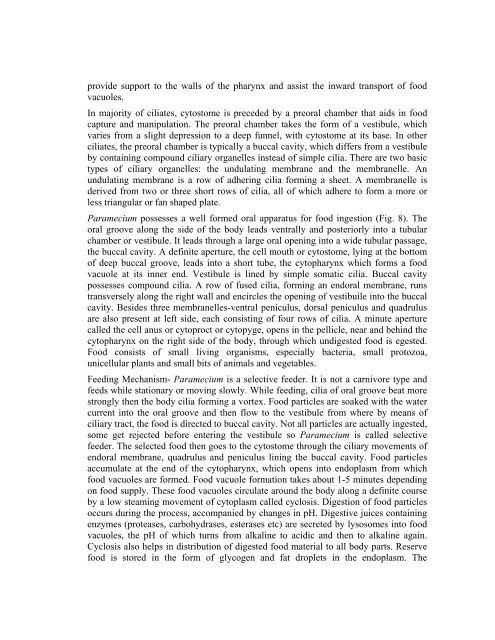ANIMAL DIVERSITY – I (NON-CHORDATES)
ANIMAL DIVERSITY – I (NON-CHORDATES)
ANIMAL DIVERSITY – I (NON-CHORDATES)
Create successful ePaper yourself
Turn your PDF publications into a flip-book with our unique Google optimized e-Paper software.
provide support to the walls of the pharynx and assist the inward transport of food<br />
vacuoles.<br />
In majority of ciliates, cytostome is preceded by a preoral chamber that aids in food<br />
capture and manipulation. The preoral chamber takes the form of a vestibule, which<br />
varies from a slight depression to a deep funnel, with cytostome at its base. In other<br />
ciliates, the preoral chamber is typically a buccal cavity, which differs from a vestibule<br />
by containing compound ciliary organelles instead of simple cilia. There are two basic<br />
types of ciliary organelles: the undulating membrane and the membranelle. An<br />
undulating membrane is a row of adhering cilia forming a sheet. A membranelle is<br />
derived from two or three short rows of cilia, all of which adhere to form a more or<br />
less triangular or fan shaped plate.<br />
Paramecium possesses a well formed oral apparatus for food ingestion (Fig. 8). The<br />
oral groove along the side of the body leads ventrally and posteriorly into a tubular<br />
chamber or vestibule. It leads through a large oral opening into a wide tubular passage,<br />
the buccal cavity. A definite aperture, the cell mouth or cytostome, lying at the bottom<br />
of deep buccal groove, leads into a short tube, the cytopharynx which forms a food<br />
vacuole at its inner end. Vestibule is lined by simple somatic cilia. Buccal cavity<br />
possesses compound cilia. A row of fused cilia, forming an endoral membrane, runs<br />
transversely along the right wall and encircles the opening of vestibuile into the buccal<br />
cavity. Besides three membranelles-ventral peniculus, dorsal peniculus and quadrulus<br />
are also present at left side, each consisting of four rows of cilia. A minute aperture<br />
called the cell anus or cytoproct or cytopyge, opens in the pellicle, near and behind the<br />
cytopharynx on the right side of the body, through which undigested food is egested.<br />
Food consists of small living organisms, especially bacteria, small protozoa,<br />
unicellular plants and small bits of animals and vegetables.<br />
Feeding Mechanism- Paramecium is a selective feeder. It is not a carnivore type and<br />
feeds while stationary or moving slowly. While feeding, cilia of oral groove beat more<br />
strongly then the body cilia forming a vortex. Food particles are soaked with the water<br />
current into the oral groove and then flow to the vestibule from where by means of<br />
ciliary tract, the food is directed to buccal cavity. Not all particles are actually ingested,<br />
some get rejected before entering the vestibule so Paramecium is called selective<br />
feeder. The selected food then goes to the cytostome through the ciliary movements of<br />
endoral membrane, quadrulus and peniculus lining the buccal cavity. Food particles<br />
accumulate at the end of the cytopharynx, which opens into endoplasm from which<br />
food vacuoles are formed. Food vacuole formation takes about 1-5 minutes depending<br />
on food supply. These food vacuoles circulate around the body along a definite course<br />
by a low steaming movement of cytoplasm called cyclosis. Digestion of food particles<br />
occurs during the process, accompanied by changes in pH. Digestive juices containing<br />
enzymes (proteases, carbohydrases, esterases etc) are secreted by lysosomes into food<br />
vacuoles, the pH of which turns from alkaline to acidic and then to alkaline again.<br />
Cyclosis also helps in distribution of digested food material to all body parts. Reserve<br />
food is stored in the form of glycogen and fat droplets in the endoplasm. The
















